Disease |
Affected Plants |
Symptoms |
Prevention & Control |
|---|---|---|---|
Anthracnose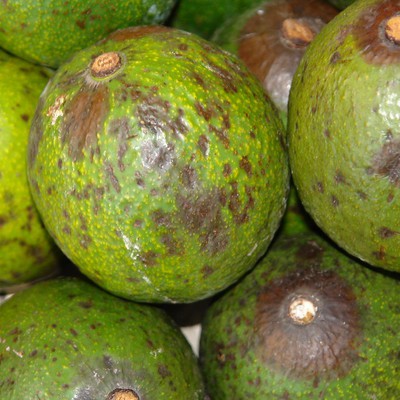
|
This fungal disease affects many plants including vegetables, fruits and trees. Tomatoes, Cucumbers, Melons, Beans, Avocado & Mango trees are particularly susceptible. |
Anthracnose can affect any part of a plant. Plant leaves present with small, yellow or brown spots that are irregular in shape. As leaves age, these spots darken and expand in size. On trees, both the leaves and young twigs are affected, in severe cases defoliation can occur. Fruits are also affected and will present with dark, sunken spots. Pink spores will begin to emerge within these sunken spots, triggered by periods of wet weather. The disease will remain dormant in immature fruit and present itself when the fruit begins to ripen. |
Controlling Anthracnose on plants is often a loosing battle, the best course of action for edible plants that have been infected is to remove them from your garden and carefully dispose of them. Trees will most often recover quite well, prune off the affected wood and leaves and dispose of them carefully. Plants can be sprayed with copper-based fungicides, however copper can build up in the soil and negatively impact the soil life so be mindful of how often you use it. Prevention: With Anthracnose, prevention is key. When buying edibles from your nursery, make sure they look healthy with green foliage that is blemish free. Ensure that your soil is well-draining by mixing in good quality compost before planting. Avoid overhead watering as fungal diseases prefer moist environments. Practice good hygiene in your garden by cleaning pruning equipment between plants. Prune off leaves or fruit that are touching the soil and mulch well to prevent splash back of soil onto leaves. Practice crop rotation on seasonal crops. |
Bacterial Canker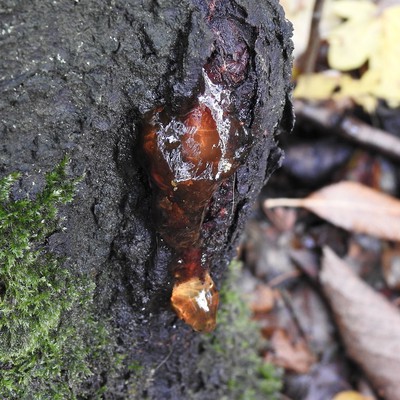
|
Most common on Cherries and Plums but will also affect Nectarine, Apricot, Peach and other stone fruit trees. |
Bacterial Cankers present with water-soaked, gummy looking lesions that form on the trunk or branches of trees. A sour smelling, rust coloured sap may ooze from these lesions. The cankers will look darker than the surrounding bark. The leaves above the diseased area will curl, turn yellow and eventually stop producing new growth. |
Bacterial Canker infections occur during cool, wet weather and are spread by water or transfer from pruning tools. The bacteria enters the tree through injured bark or pruning wounds. Careful pruning, and cleaning of tools prior to pruning is essential. Prune trees in late winter where possible and prune any affected limbs well below infected areas. Treat the pruned site with a pruning sealer to protect it from further infection. Remove weeds, grass and other debris from around the base of trees to improve air flow and to limit potential moisture build up around the trunk. Trees that are stressed are more likely to be affected. Ensure that your tree is planted well draining soil with adequate nutrition. |
Blossom-End Rot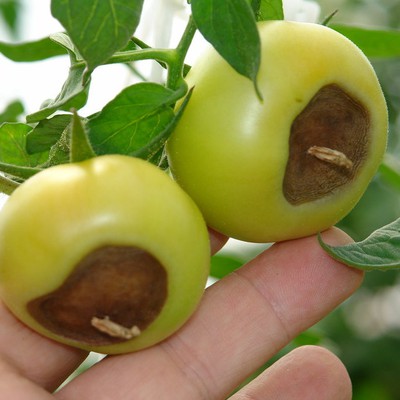
|
A common problem in Tomato, Peppers, Eggplant and Squash. |
Blossom-End Rot usually occurs in immature fruit. It starts with a small, depressed, water-soaked area on the blossom end of the fruit. As the spot enlarges, it becomes sunken and turns dark brown or black in color and appears leathery. Blossom-End Rot is caused by a low concentration of calcium in the fruit (Calcium is needed for normal cell growth). Blossom-End Rot usually occurs when there are wide fluctuations of moisture in the soil which reduces uptake of calcium into the plant. When the demand for calcium exceeds the supply, the tissues break down. |
Blossom-End Rot is usually caused by a lack of Calcium in the soil. Several factors can contribute to calcium deficiency, so it can be a process of elimination to figure out the cause. Remove any affected fruit and apply a calcium fertiliser so that the plant can work on producing healthy fruit. Prevention: Add crushed eggshells, gypsum or bone meal to the transplant hole at planting to help prevent the issue from arising. Soils that are too dry or too wet are problematic. Maintain consistent soil moisture levels throughout the growing season by watering deeply twice a week in hot, dry weather. Only water if the soil is dry at a fingers depth. Allow the soil to warm before planting, crops which are planted in cold soil have a harder time up-taking nutrients. Apply mulch to maintain consistent soil moisture. Be extra careful of damaging root zones if cultivating the soil around your plants, stake your plants when they are young to limit any root damage later on. Root damage significantly stresses plants. Soils which are too high in nitrogen can also cause Blossom-End Rot, limit the use of high nitrogen fertilisers while your plants are fruiting. Maintain a soil pH of around 6.5 to prevent Blossom-End Rot. |
Brown Rot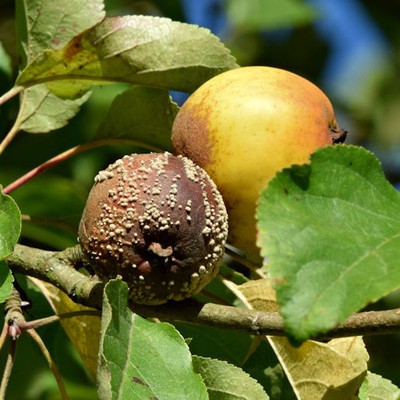
|
Affects Almonds, Apricots, Cherries, Peaches, Plums and Nectarines. |
Symptoms usually appear after a wet and humid spring. The disease first presents with brown, wilted blossoms that form a grey fuzzy mass. It soon spreads to the twigs, forming cankers and killing new growth and flower-bearing stems. Maturing fruits develop a small brown rotted spot which grows rapidly, destroying the fruit. Brown Rot spores are spread by wind, rain and insects and settle on blossoms and young shoots. If moisture is present on the leaves or shoots, the spores will become active and quickly penetrate the plant. |
Good sanitation in the garden is essential to avoiding Brown Rot. Remove all fruit from the tree after each growing season to prevent diseases taking hold and overwintering in the fruit. Overwintered diseases will strike in spring and affect next seasons crop. Infected fruit or tree stems should be disposed of carefully or burned (do not compost). Use an organic fungicide regularly as directed on the bottle. Start treatment in the early spring, prior to flower buds appearing. Pruning is essential for the control and prevention of Brown Rot disease. Prune off any dead or unproductive wood and open up the center of the tree to let light and air in. Remove any overlapping branches to prevent moisture build up. Disinfect the pruners between cuts. Protect your crop against insect damage as small wounds from insects can create openings for the fungus to settle into. |
Clubroot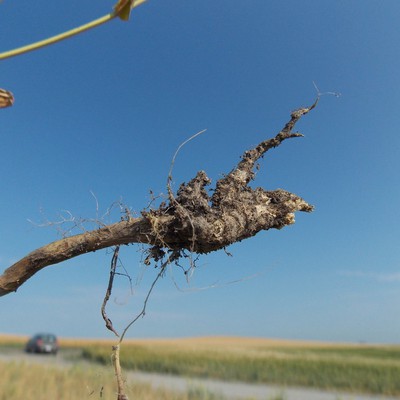
|
Affects most Brassica crops including Cabbage, Broccoli, Cauliflower, Kale, Brussels Sprouts. |
Clubroot is caused by a pathogen called Plasmodiophora Brassicae. The infection starts in the plant’s root hairs and is contracted from infected soil. After infection, spores rapidly produce in the plants roots causing them to become swollen, distorted and club like. Above ground, plants appear stunted and will wilt with even slightly warm daytime temperatures. Leaves appear yellow, purple or brown. Plants produce low quality crops or many not even produce at all. Below ground, roots are swollen, distorted and resemble large clubs. Early in the season, clubbed roots are firm and lightly coloured, roots darken in colour and begin to decay as the season progresses. Due to the damage caused by this pathogen, affected plants have great difficulty absorbing water and nutrients often resulting in total crop failure. |
Unfortunately, the only course of action after plants have been affected is to carefully remove them from the garden. Take care to remove the entire root system, dispose of plants carefully, do not place the affected plants in your compost bin. Fungal spores will quickly spread by water, wind and infected garden tools. The pathogen is often triggered by excessive moisture and high soil temperatures. Make sure your soil is well draining and that you are planting at the right time in the season. Ensure that your garden tools are sterilised between use. Use a soil testing kit to check your soils pH. To avoid Clubroot, the pH of your soil should be neutral at roughly 7.2. If your soil is acidic, you can mix dolomite lime or oyster shell into your soil in autumn. The spores can survive in soil for over 10 years, so crop rotation is essential, particularly after an infected crop. If purchasing seedlings from a nursery, make sure they look healthy. It's best not to introduce sickly seedlings into your garden. Control weeds around your garden as they may carry the pathogen. |
Damping Off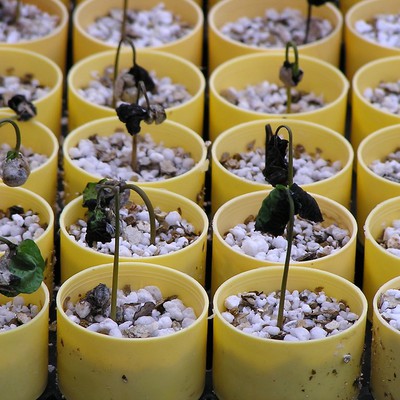
|
Many seeds and young seedlings. |
Damping off can be caused by a number of soil-borne fungi. Damping off can present in two ways, seeds can decay in the soil and rot before they emergence or, newly emerged seedlings wilt and collapse, dying from rot at or just below the soil line. Woody seedlings may wilt and wither but remain upright. Seeds or seedlings planted in cold wet soils are mostly affected. Mature plants are less commonly affected. |
Prevention is the only method when it comes to Damping-Off, once plants are affected there is no cure. Damping-Off can be avoided by starting seeds in light, well-draining soil. Sterile seed starting mixes can also be used. Avoiding planting in cold or shaded soils. Good air circulation is essential, avoid overcrowding your plants. Plant your seeds at the recommended depth according to the seed packet, planting too deeply can be cause the seedlings to rot before they emerge. Be careful not to over water or over fertilise. Seeds and young seedlings often don't need fertiliser until they develop their true leaves. Good sanitation, such as cleaning seed trays thoroughly before and after use is essential to preventing disease. Try and avoid overhead watering, seedling trays that provide water from below are perfect. Water in the mornings so that the soil doesn't stay moist over night. |
Downy Mildew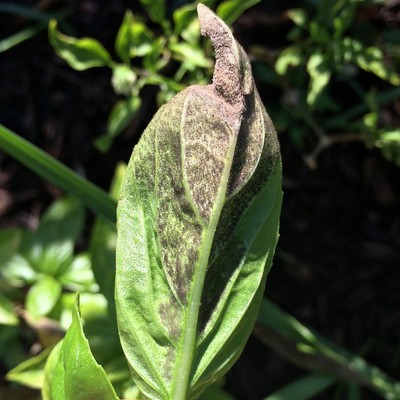
|
Affects many plants including Brassicas/Cabbage Family crops, Cucurbits/Squash Family crops, Onions, Lettuce, Basil, Grapes. |
The tricky thing about Downy Mildew is that it presents in different ways, depending on the type of plants it is infecting. Often, plants infected with Downy Mildew will form fuzzy looking growth on the undersides of leaves that is grey, brown, purple or white. Mottling or spots on the tops of leaves may also form, these can be yellow, light green, brown, black or purple in colour. Plants that are affected by downy mildew may be stunted or suffer from leaf loss. Downy Mildew often appears after wet weather and thrives in humid conditions.
|
Downy Mildew needs moist conditions to survive, so the key is to keep the foliage of susceptible plants dry. Avoid overhead watering, particularly in the evening as leaves will stay moist over night. Use drip irrigation or hand water at the plants base in the morning. Avoid watering in cool conditions. Keep your garden clean and free of garden waste and debris, as they may trap moisture and harbor the disease. Ensure that your plants have adequate space between them so that all parts of the plant have good airflow and access to sunlight. Use a milk or baking soda spray on the foliage, focusing on the underside of leaves. Water plants with a seaweed solution. Check out the 'Maintaining Your Garden' guide for more information on these sprays. |
Early Blight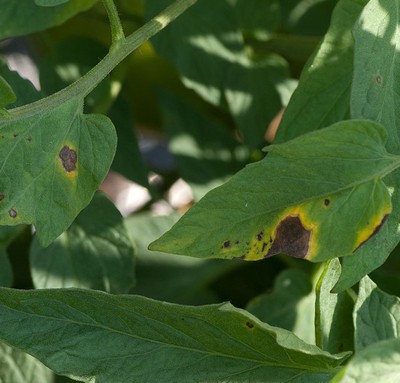
|
Very common in Tomato and Potato plants. |
Early Blight occurs on the foliage, stem and fruit of Tomato plants, as well as the foliage, stem and tubers of Potato plants. Early Blight is caused by the fungus Alternaria Solani. Symptoms first appear on the lower leaves and work their way up the plant. Plants develop small brown lesions, usually on the foliage. As the blight progresses the lesions expand in size and develop a yellow halo around them, this halo is characteristic of Early Blight and is often referred to as a 'Bullseye'. Affected plant leaves eventually turn yellow, wither and die. Lesions appearing on the stem are often round and sunken. Infected Tomato fruit will present with lesions that appear as concentric rings. Fruit will often drop prematurely.
|
At the end of the season, remove any plants making sure your remove all of the roots, fruit or tubers and dispose of them. Do not compost any affected plant matter. Blight can overwinter in debris, soil and even seed. Don't save seeds from affected plants and remove any volunteer plants that emerge. Prepare the soil well. Tomatoes require well draining soil that has been enriched with good quality compost. Plants that are nutrient deficient will be the first to succumb to diseases. Plant tomatoes in a full sun position. Tomatoes require a minimum of 6-8 hours of direct sunlight daily. Sunlight is essential to preventing moisture build up on plant foliage, most plant diseases are triggered by excess moisture. Mulch the soil around your plants to prevent the splash back of wet soil onto the leaves. It's also beneficial to cut off any leaves that are close to or touching the ground, this will prevent soil borne diseases from colonizing on your plants. Ensure good airflow between plants. Trim off any overlapping leaves as they may trap moisture, leading to blight. Baking Soda Spray- Baking Soda works by creating an alkaline environment so that blight cannot colonize on the leaves. This can be applied fortnightly as a preventative measure or control on mild cases. Spray weekly if blight is quite active on your plants (see 'Maintaining Your Garden' for the recipe and application method). |
Fire Blight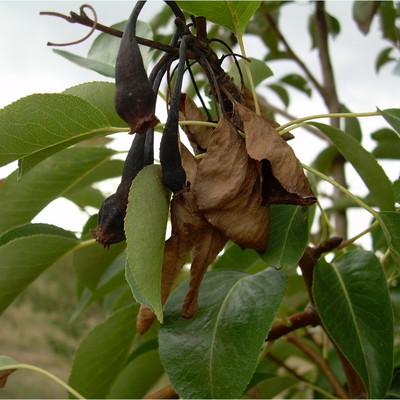
|
Commonly presents on Apples, Pears, Quince, Rose bushes and Raspberries. |
This bacterial disease (Scientific name- Erwinia Amylovora) usually presents in spring, starting at branch tips and killing new growth. The disease works in three phases, beginning with Blossom Blight, then Shoot Blight and eventually progressing to Canker and Collar Blight. The Bacteria overwinters in infected bark. Trees develop reddish-brown, water-soaked looking lesions that will ooze a tan colored liquid in spring. The ooze is attractive to insects, who then spread it to blossoms. Once the blossom is infected it spreads down the stem into the shoots and if not controlled, into mature wood. Blossoms, fruit spurs, leaves, twigs are the first to be affected, turning brown/black and crispy with a scorched like appearance. The dead leaves remain attached to the tree rather than dropping off. The bacteria spreads quickly in warm conditions that are accompanied by periods of rain or heavy dew. |
Select resistant varieties where possible. Plant trees in a full sun position, with correct spacing and in well draining soil. Control sap sucking insects such as Aphids and Leafhoppers as they will spread the disease from one plant to another. In warm, wet springs, monitor your trees carefully and regularly for Blossom Blight and Shoot Blight and prune off affected areas as soon as you find them. Avoid over fertilisation. Fire Blight spreads rapidly through young growth that has been stimulated by high nitrogen fertilisers. Remove all affected branches in late summer, autumn or winter as the disease is least active at these times. Only prune on sunny days, with no predicted rain for at least 48 hours, this allows the cuts to dry thoroughly. Prune off infected branches as soon as you discover them. Prune roughly 30cm below the infected area, burn or carefully dispose off the infected plant matter (do not compost it). Disinfect pruning equipment between each cut to avoid transferring the disease from one branch to another. Organic fungicides can be applied as a prevention or at the first sign of disease. Ask your local nursery for a recommendation and follow the directions on the bottle carefully for details on how to apply it. |
Fusarium Wilt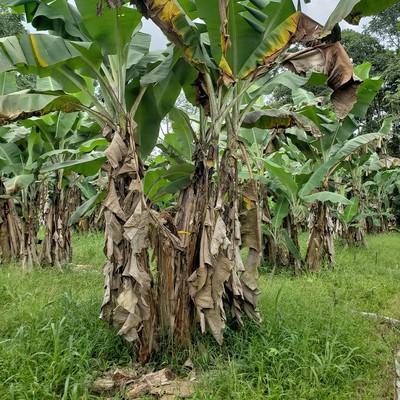
|
Affects many plants including Potato, Eggplant, Peppers, Basil, Brassicas, Curcubits/Squash Family crops, Lettuce, Alliums, Peas, Snake Beans, Ginger and Bananas (known as Panama Disease in Bananas). |
Fusarium Wilt is a soil borne fungus which enters plants through the root system. This fungus interferes with the plants ability to absorb water. As the infection progresses into plant stems and leaves it causes the foliage to wilt and turn yellow. Disease symptoms usually appear later in the growing season and are first noticed in the lower leaves. The younger leaves are next to be affected, eventually killing the plant. In many cases, only one side of the plant will show symptoms. The fungal disease develops in hot, dry conditions and is particularly destructive when soil temperatures exceed 25ºC. Dry weather, low soil moisture and soil compaction are high risk factors for the disease.
|
Fusarium Wilt is hard to control, so the key here is definitely prevention. Follow the 'Maintaining Your Garden' guide for all of the essential ways to prevent diseases in your garden. Good garden hygiene and watering practices are key in preventing Fusarium Wilt. Once plants are affected, promptly remove them from your garden. Be careful to remove all of the roots, leaves and/or fruit and carefully dispose of them or burn them (do not compost them). This fungus can live in soil indefinitely, even without the presence of a host plant and can be harbored in old plants and debris. Wash off any gardening equipment and shoes that have been in contact with the soil. A method which is effective in eliminating Fusarium, is Soil Solarisation. Solarisation uses energy from the sun to raise soil temperatures to an extremely high level, essentially cooking any diseases or pests that are present. Solarisation can be used for both in-ground and raised bed gardening. It simply involves covering the soil with a layer of thin, clear plastic. This is best carried out in the summer months when the sun is at it's strongest. The first step is to clear out your garden bed to expose the bare soil. Till the soil, ensuring it is free of debris and rake the soil so that it is leveled and flat. Lightly spray the soil with water, as moisture is effective in heating up the soil. Lay the plastic cover over the soil and secure it, the plastic should be in direct contact with the soil. Ensure that the edges of the plastic are buried with an outer trench or completely secured so that no heat can escape from the sides. Leave the soil covered for a month. While soil solarisation is a great solution to Fusarium Wilt, it also depletes the soil of beneficial soil life. After solarisation is complete, it is important to regenerate the soil life. You can do this by mixing in fresh compost and feeding the soil with organic matter such as seaweed solution, fish emulsion and worm casting before replanting. |
Gray Mold (Botrytis)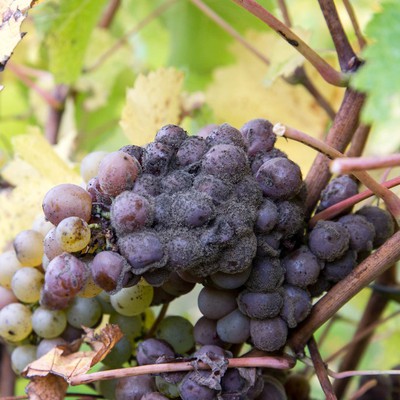
|
Found on a very wide range of plants. |
Gray Mold or Botrytis Blight (Botrytis Cinerea) is a fungal disease that is prominent during cool, wet or damp weather conditions. Symptoms present as soft, mushy brown spots on buds, flowers and fruit. The infection can also spread to leaves and stems. The soft spots become covered in gray fungus spores that can cause seedlings and young shoots to collapse, and buds, flowers and fruit to rot. High humidity greatly increases the risk of Gray Mold. The fungus commonly enters the plant on damaged areas. Gray mold is often found close to the soils surface and can spread very quickly. The disease may also occur after harvest when fruit has been stored, causing premature rotting of produce, often seen in strawberries. |
Gray Mold overwinters on plants, plant debris and in soil. Spores require cool temperatures and high humidity to germinate. In order to avoid this disease, plants require adequate spacing, good air flow and good access to sunlight. Germinating spores rarely infect healthy plant tissue, they enter through wounds on plants. Pruned areas are particularly susceptible to infection. Be careful when pruning, ensure that you are using clean gardening equipment. Take extra care not to damage existing plants or plant roots when cultivating the soil around your garden. Carefully remove the affected parts of the plant and dispose of them (do not compost), clean the pruners between each cut as not to further reinfect your plant. Handle your plants carefully when transplanting and harvesting as not to create open wounds. Ensure that leaves have ample time to dry after watering or just water at the base of the plant. Water sitting on plant foliage for extended periods of time, particularly throughout the night, greatly increases the risk of developing Gray Mold and many other diseases. |
Late Blight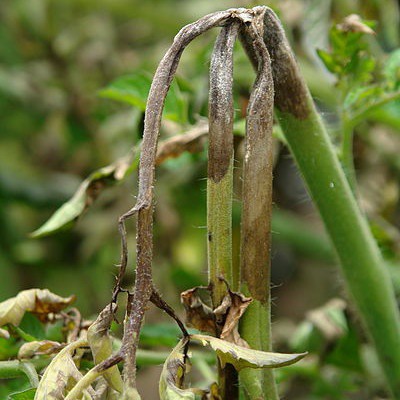
|
Causes devastation in Tomato and Potato plants. Also affects Chilies, Peppers and Eggplants although not as severely. |
Late Blight is caused by the fungus-like microorganism Phytophthora Infestans. The disease occurs later into the growing season and is at it's peak during cool, wet summers. Large, pale green areas form on leaves which soon darken to a greyish-brown, these lesions have a water-soaked appearance. As the disease progresses, white spores appear on the undersides of the leaves. The lesions and spores can also appear on the stems of plants. Potato tubers can be affected with a brown to purple toned rot that goes as deep as 1.5cm into the tuber. They have an uneven, cork like texture inside and can become foul smelling if affected by secondary infections. Secondary fungi and bacteria will often invade tubers after they have been infected by blight, causing the tubers to break down. Even seemly healthy tubers can begin showing symptoms after harvest. Tomato fruits are also affected, infected fruits present with firm dark brown lesions which very quickly destroy the whole fruit. |
Prevention is key with Late Blight. Unfortunately there is no cure for Late Blight and once it has taken hold, the disease progresses quite quickly. Prevention: At the end of the season, remove any plants making sure you remove all of the roots, fruit or tubers and dispose of them. Do not compost any affected plant matter. While Late Blight does not overwinter in soil or on debris, it is prone to re-emerging on volunteer plants, particularly Potato tubers that have been left in the ground. Prepare the soil well. Tomatoes require well draining soil that has been enriched with good quality compost. Plants that are nutrient deficient will be the first to succumb to diseases. Plant Tomatoes in a full sun position. Tomatoes require a minimum of 6-8 hours of direct sunlight daily. Sunlight is essential to prevent moisture build up on plant foliage, most plant diseases are triggered by excess moisture. Mulch the soil around your plants to prevent the splash back of wet soil onto the leaves. It's also beneficial to cut off any leaves that are close to or touching the ground. This will prevent soil borne diseases from colonizing on your plants. Ensure good airflow between plants. Trim off any overlapping leaves as they may trap moisture, leading to blight. Baking Soda Spray- Baking Soda works by creating an alkaline environment so that blight cannot colonize on the leaves. This can be applied fortnightly as a preventative measure. Spray weekly if blight is quite active on your plants (see 'Maintaining Your Garden' for the recipe and application method). |
Leaf Curl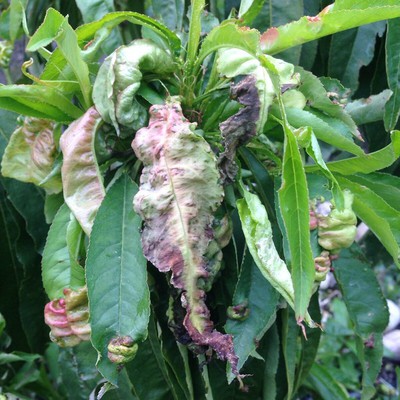
|
Affects Peaches, Nectarines and other stone fruit. |
Characterized by red crinkling and curling leaves in spring and yellow dying foliage in the summer. Trees will often push out a second set of fresh leaves to counteract the damage, however this takes energy away from growing and ripening the fruit. Leaf Curl is a manageable disease, however if left untreated long term, it can cause significant damage or death to trees. Wet cool springs are the ideal conditions for the spread of disease. The new flower buds and fresh leaf growth can be infected with overwintering fungus, the wet conditions allow the fungus to spread throughout the tree. |
Leaf Curl is a manageable disease, especially when treated early. While there isn't much that you can do treat an infected tree during spring time, you can make sure that your tree is well watered and fed with an organic fertiliser. Feeding and watering your plant well will reduce plant stress and give your tree the extra energy it needs to put out a second set of leaves. Foliar feeding is a great way to help your tree put out it's second set of leaves. Feed with a seaweed solution as well as fish emulsion. You can also apply these to the base of the plants to be absorbed by the roots. Thinning some of the fruit on the infected tree is also beneficial so that the tree won't be further weakened by trying to grow and ripen fruit with it's reduced foliage. Copper fungicides are organically approved for used in treating Leaf Curl. Spray the tree thoroughly in the dormant season (when the leaves have fallen off). One application should be enough, although as an added measure, you can apply another treatment in spring before the buds begin to swell, particularly after periods of heavy rain. Only use copper sprays as required and try to limit excessive run off into the soil. Copper can accumulate in the soil and kill beneficial soil life. Follow the application instructions on the bottle carefully. Clean up any fallen leaves and dispose of them promptly (do not compost). |
Leaf Spot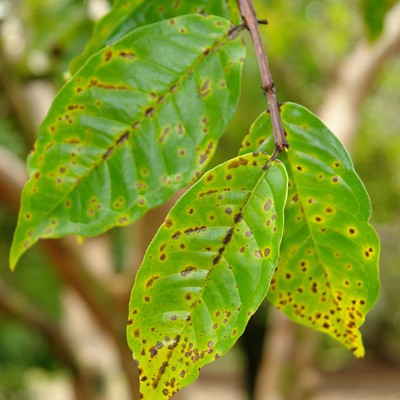
|
Affects a wide range of plants. Stone Fruit trees are particularly susceptible to bacterial leaf spot, as are Tomato, Pepper, Chilli and Eggplant crops. Fungal leaf spot is common in lettuce crops, it also affect Brassicas/Cabbage Family crops. |
Leaf Spot falls into two categories- bacterial and fungal. Spotting of either kind is generally quite similar in appearance, effect and treatment. Leaf spot fungi and bacteria are soil borne and are most prominently in spring, particularly after periods of rain. Rain causes soil to splash onto plants, allowing the disease to penetrate the leaves. Once infected, small spots will begin to appear on leaves. The spots are usually brown or black in colour, sometimes appearing with a halo around them. As the disease progresses, the spots enlarge and merge together, particularly in wet conditions. The leaves may also turn yellow, wither and drop. In drier conditions the spots are more speckled in appearance and take longer to spread. Spots caused by fungus may also produce spores which can cause secondary infections on leaves. |
Stressed plants and trees are most at risk of Leaf Spot. It's important to feed your plants with a well balanced organic fertiliser and seaweed solution in early spring to help boost your plants immune system. Damaged plants are also more susceptible to Leaf Spot infections, take care around your plants and always prune using clean, sharp pruning tools. Keep pests at bay by following the organic methods outlined in our 'Maintaining Your Garden' and 'Pests' guides. Plants that are stressed due to pest damage are at increased risk of developing many diseases and infections including Leaf Spot. Tim off any affected leaves and dispose of them promptly (do not compost them). Trimming off infected leaves helps to prevent Leaf Spot from spreading. Remove dead leaves from in and around your garden. Mulch the soil well to prevent the splash back of wet soil onto plant leaves. Prune and stake plants, particularly tomatoes, to improve air circulation. Disinfect your pruning tools between cuts. If buying seedlings or trees from a nursery, make sure they look healthy and that their leaves are spot free. Ensure that leaves have ample time to dry after watering, or avoid overhead watering altogether and just water at the base of the plant. Water sitting on plant foliage for extended periods of time, particularly throughout the night, greatly increases their risk of developing Leaf Spot. For an organic treatment, you can purchase a sulfur or copper based spray. You can also use a mild home-made baking soda spray (1 tablespoon of baking soda, 2 tablespoons of cooking oil, a few drops of mild dish soap to 1 gallon of water). Always do a spot test on a few leaves before spraying the entire plant. Do not spray newly germinated or newly transplanted seedlings. Check the 'Maintaining Your Garden' guide for the application method. |
Mosaic Virus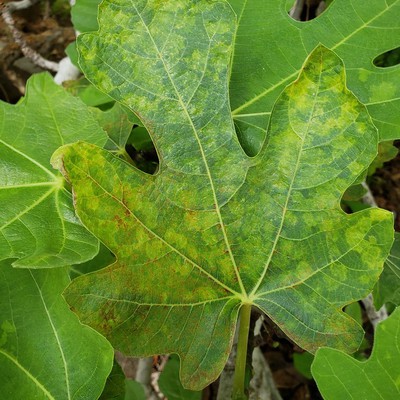
|
Affects a very wide variety of crops including Tomatoes, Potatoes, Eggplants and other crops from the Potato / Nightshade Family, crops from the Squash/Cucurbit Family, Beans, Passionfruit and many more. |
Mosaic Virus is characterised by leaves that are mottled with patches of yellow, light or dark green through them. Leaves also present with varying levels of deformity, such as unusually shaped leaves that may be wavy, crinkled and blister like in appearance. Plants are often stunted or grow poorly. Plants that are infected by Cucumber Mosaic Virus present with leaf malformation in which the edges of the leaves fail to develop. |
Unfortunately, the only course of action after plants have been affected is to carefully remove them from the garden. Take care to remove the entire root system, leaves and fallen fruits and dispose of them carefully. Do not place the affected plants in your compost bin. Mosaic viruses are most commonly spread by Aphids. Once you spot Aphids in your garden, it's best to act quickly. Wash aphids off with a blast of water from the hose, water pressure is often enough to kill them. Yellow sticky traps around the base of your plants or placed throughout your garden are also a good form of control. Most beneficial insects feed on Aphids, so try attracting some to your garden. Insecticidal soap and botanical oil based insecticides, work well to smoother these pests. Fruit-fly mesh and other forms of exclusion work well to protect crops. Control weeds from in and around your garden. Some weeds may serve as hosts for the virus. |
Powdery Mildew
|
A wide variety of plants, including those from Curcurbit/Squash Family, Peas, Grapes and Strawberries. |
Powdery Mildew is a fungal disease which presents as a white powdery substance on plant leaves. The disease may appear on the surface and/or undersides of leaves. At first, Powdery Mildew will appear as small circular white spots, if left to progress the affected plants will look as though they have been dusted with flour. Low soil moisture in combination with high humidity is a risk factor for Powdery Mildew. This fungal disease robes plants of nutrients and if left untreated, plants will become weak and slow down in growth and crop production. As the disease progresses, leaves will turn yellow and dry out. Powdery Mildew is made up of tiny spores which spread with wind, carrying the infection to other plants. This fungal disease has the potential to spread very fast. Symptoms usually appear later into the growing season. |
While there is no cure for Powdery Mildew, you can stop the spread by following a few simple methods. Prune off any badly affected leaves and carefully dispose of them (do not compost them). Be sure to disinfect pruning tools between plants. Remove any diseased foliage or debris off the ground and dispose of them. Apply a thick layer of mulch around your plants to stop any spores that may be on the soils surface from splashing up onto your leaves. Once the plants have been pruned and the area cleaned of debris, apply a milk spray to treat the plants. Milk sprays work wonders for Powdery Mildew. Spray plants with a ratio of 30% milk to 70% water. Don't worry if your ratio is a little off, the spray will still work with a lower dilution of milk and a higher milk content won't harm your plants. Spray the leaves including the undersides, stems and base of the plant. For best results, spray plant leaves every 10-14 days. Try and avoid overhead watering, moisture sitting on foliage particularly overnight or in humid weather may contribute to the spread of the fungus. |
Rust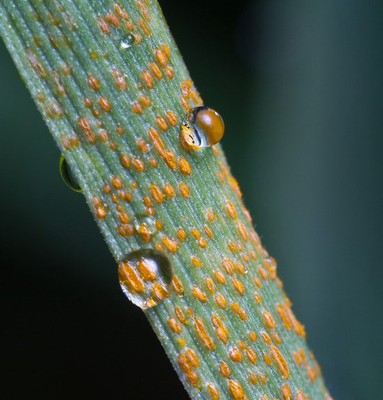
|
Affects a wide range of crops, particularly Garlic and Beans. |
Rust is a fungal parasite that colonizes on plants. It most often occurs in moist, cool conditions and is spread by spores which travel between plants through wind, water or transfer from gardening equipment. It often occurs after periods of wet weather and excess moisture. Rust begins with yellow or white spots which appear on plant leaves. After that comes reddish, brown or orange spots on the leaves, similar to what you would see on rusty metal objects. As the rust progresses on the plant, it will cause leaf yellowing and leaf drop. While rust doesn't kill your plant, it does cause a decline in plant health, leading to reduced flower and fruit production. |
While there is no real cure for rust, there are ways to slow down the spread. Start by removing all the infected parts of the plant and dispose of them (do not compost them). Dispose of any debris around your garden to reduce excess moisture and to encourage good air flow between plants. Copper and Sulfur treatments have been proven to be effective against rust, but must be applied at the first sign of infection. Your local nursery will be able to advise which product is best, be sure to follow the label on the bottle carefully. If Copper is used too frequently it can build up in the soil and negatively affect soil health. Prevention Ensure that your plants are in a full sun position and are spaced appropriately. Plants with good access to sunlight and good airflow are less likely to develop rust. Avoid overhead watering and water in the morning so that plants have ample time to dry. |
Verticillium Wilt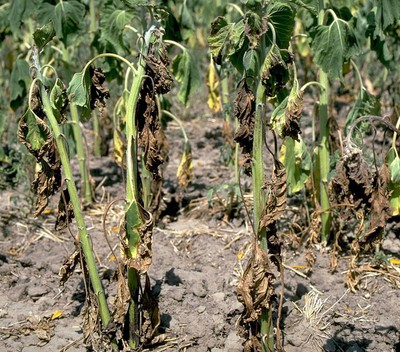
|
A wide variety of plants, including Eggplants, Potato, Tomato, Strawberries and plants from the Cucurbits / Squash Family. |
Verticillium Wilt is a soil borne fungul disease which infects plants through their root system, moving upwards into the plant tissue. The disease affects the plants ability to process water, leading to water stress. Affected plants will present with curled leaves that soon wilt, discolor and die. Stems and branches will also die back, sometimes only one side of the plant will display these symptoms. Verticillium Wilt may occur suddenly in hot weather, plants may seem to recover when weather cools down, but symptoms most likely re-appear. Wilting is mostly seen from spring until autumn. |
There is no cure for Verticillium Wilt, small plants should be removed from your garden and disposed of (do not compost them). This disease will remain in the soil even after the plant is removed, so don't plant any other susceptible plants in the same garden. For established trees and large shurbs, treatment involves regular care in order to build up their resistance to the disease. Water regularly and where possible, try and eliminate heat stress by providing afternoon shade while they recover. Fertilise on schedule, using an organic fertiliser as well as a seaweed solution. Prune off any dead branches. A method which is effective in eliminating Verticillium Wilt, is Soil Solarisation. Solarisation uses energy from the sun to raise soil temperatures to an extremely high level, essentially cooking any diseases or pests that are present. Solarisation can be used for both in-ground and raised bed gardening and simply involves covering the soil with a layer of thin, clear plastic. This is best carried out in the summer months when the sun is at it's strongest. The first step is to clear out your garden bed to expose the bare soil. Till the soil, ensuring it is free of debris and rake the soil so that it is leveled and flat. Lightly spray the soil with water as moisture is effective in heating up the soil. Lay the plastic cover over the soil and secure it, the plastic should be in direct contact with the soil. Ensure that the edges of the plastic are buried with an outer trench or completely secured so that no heat can escape from the sides. Leave the soil covered for a month. While soil solarisation is a great solution to Fusarium Wilt, it also depletes the soil of beneficial soil life. After solarisation is complete, it is important to regenerate the soil life. You can do this by mixing in fresh compost and feeding the soil with organic matter such as seaweed solution, fish emulsion and worm casting before replanting. |